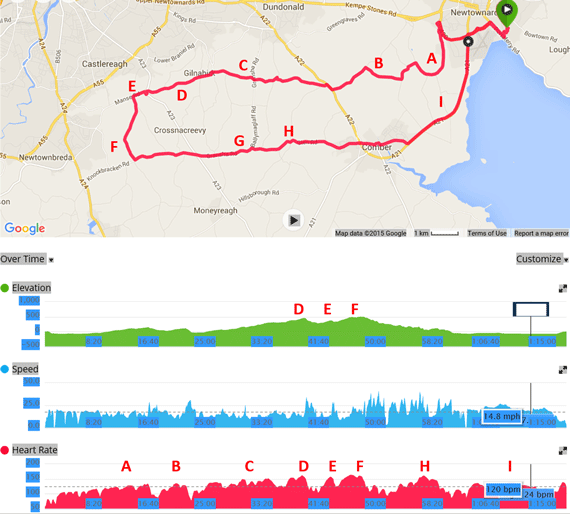In the previous article we looked at a series of training sessions to prepare you for the road racing season, based on a road circuit and making a progressive number of big efforts.
This article is also based on a road circuit, and making efforts. But this time the goal of the training is slightly different, and we’ll spend more time looking at how to analyse how well the rider has achieved the objectives of the session.
The circuit is shown in the map below. It starts in Newtownards, heads out round the front of Scrabo, and then out into the Braniel hills, before looping back home through Comber. The green graph below the map shows elevation – you can see that the route gradually climbs on the way out, peaking on three hills – Upper Braniel Road (D), Manse Road (E) and Lisnabreeny Road (F) – before heading back down to Comber and a flat run home to Newtownards.

The goal this time is to make three big efforts on the three main hills (marked D, E and F). On the way out, you might make some smaller efforts in the build up to the “big three” (for example at A, B and C). The return journey to Comber is largely downhill, but quite tricky and technical – the aim now is to sprint over the small hills (e.g. at G and H), while keeping the speed high through the conners to improve your technical skills when your legs are burning and your heart is pumping. If you can make one final big sprint in the final run in to Newtownards that’s a bonus!
This could simulate a club road race – you start in the middle bunch and make some steady efforts as the group works together. Then the scratch group catches you, and you have to make a number of big efforts to stay with them. As things settle down again, you need to cope with the higher speed, and the final attacks in the run in to the finish.
So how did this rider do in the session? His speed is shown in the blue graph, and his heartbeat in the red graph. He’s a bit older, so his maximum heart rate is about 160 beats per minute (a younger rider could have a max of 180 – 200bpm). Comparing the heart rate to the rider’s max is a good way of assessing the level of effort. And this rider is in his fourth week riding this circuit, so he’s well into a 5 or 6 week cycle of training.
We can make the following observations –
- You can see a steady build up in the first half, with some evidence of increasing efforts at A, B and C. This was as planned.
- You can see the three biggest efforts at D, E and F, which was also as planned. The rider comes close to his maximum heart rate at these three points.
- You can see a double bump at D – this corresponds to the rise past Castlereagh Hills Golf Club, followed by the short flat before the final climb to the summit. This sort of double effort is a very effective training technique, as outlined in the previous article. You can see a similar double bump at F, which also has a short flat before the final kick to the top. You really want to sprint for the final top to get the best out of this hill!
- If you look closely at E, you can see that the effort is not quite as intense as D or F. It looks like the rider hasn’t quite recovered from D before E arrives. This was re-enforced by the rider, who admitted he wasn’t able to make a full, 100% effort on E.
- You can see the speed rising significantly on the way back to Comber, with several spikes around 40mph. You can also see evidence that the rider put in some big efforts on the short climbs around Ballystockart (H). This was another aim of this session.
- The speed and heart rate are steady on the run home from Comber, suggesting there was to be no final sprint in this session! That’s fine – it’s better to get a proper warm down, than to make a half hearted effort.
You don’t need to analyse every training session in this level of detail. Most riders know by “feel” how hard a session has been. But it is useful to record what you’ve done, and how you feel, and to review this regularly – you can then adapt your training plan, making it more or less demanding depending on how your body is responding.
That’s it for sample training sessions – it’s now time to have a go at defining a goal, a plan and some training sessions for yourself. Good Luck!
The next article gives an overview of some of the psychological skills a cyclist needs.
